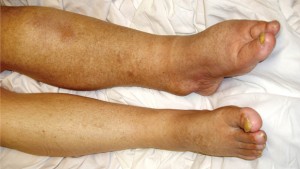By Patrick Rich –
 One of the most common issues among older patients is chronic limb swelling; swelling in the feet, ankles, calves, and arms.
One of the most common issues among older patients is chronic limb swelling; swelling in the feet, ankles, calves, and arms.
Any limb swelling whatsoever is often indicative of an overloaded lymphatic system (Lymphedema
affects approximately 140 million people worldwide) or a weakened Venus return system (commonly known as CVI or Chronic Venus Insufficiency). While Insurance/Medicare these days is pretty prohibitive on covered treatments, it does recognize both for qualifying patients and can provide compression stockings and or Lymphedema pumps designed to help control and treat the conditions. These can involve deductibles and copays.
With blockage or back up, swelling can begin. Picture an old garden hose spilling onto your lawn at full force. If you plug the hose or it backs up, it may eventually swell and weep. This would be the blood in the veins with CVI. It normally has a healthy, clear, unobstructed return to the heart. With blockage or back up, swelling can begin. Here the Lymphatic system, say a lawn with septic or sewer drains, can pick up some of the balance of this fluid and waste. Sadly, once this system is overloaded, swelling and fluid pooling will begin. This pooling often appears as protein rich waste fluid which now has nowhere to go. Initially, it will result in some minor firming of the skin and loss of hair. Skin will be compressible but will not immediately bounce back and finger pressure will leave a dent. Some “port wine colored” pooling may begin to be noticeable on the skin like bruises. This is a condition generally reversible with treatment. Eventually, with no treatment, the end result will likely be very firm, non compressible swelling. When swelling has reached this stage, the lack of flow, or lack of movement of the body’s waste products, can result in cellulitis/infection and chronic wounds in the limbs, sometimes resulting in amputation in worst cases.
Lymphedema Pump: A Non Invasive Treatment Option
Lymphedema is a degenerative disease that has no cure but in most cases can be controlled. Compression stockings are a maintenance modality designed to prevent more fluid accumulation in the limbs. When the stockings are removed, in many cases, the limbs will return to their previous condition. A Lymphedema pump, on the other hand, is a NON INVASIVE treatment modality that actually reduces the condition through a gentle massaging via inflatable compression sleeve which starts from the toes (or fingers), for example, and squeezes segmental chambers in the sleeve until the fluid is moved back into the body and simply urinated out.
It’s enlightening to see that, in most cases, the INITIAL Lymphedema pump treatment (45 minutes on average) results in a 5-12% limb size reduction. With regular treatments, frequency of swelling is reduced because it can create new channels of flow in the treatment process along with expanding existing pathways. The pump mimics what a healthier system would do. Lymphedema may be inherited (primary). It’s good for the doctor to ask about parents, siblings and children with swelling conditions in helping the diagnosis.
Stemmers sign is also a physical characteristic manifested occasionally in hereditary Lymphedema. Or, it can be caused by injury to the lymphatic vessels (secondary). It is most frequently seen after lymph node disection, surgery and/or radiation therapy in which damage to the lymphatic system is caused during the treatment.
It’s important to remember that the traumatic injury to the system may have been months or years ago, but that the swelling only recently manifested due to sometimes very small events.
Common Events that Cause Swelling May Include:
- Change in cabin pressure of a plane while flying
- Burns, including sunburn to the limb
- Bump or bruise to the limb
- Age
- Sitting too much
- Compromised Venus valves in the calves (walking and toe lifts are great to help this)
- Bug bites, sting to the limbs
- Varicose veins
- Wounds that won’t heal properly
- Surgeries
- Infection
- Injury
While this condition is commonly misdiagnosed, it can be related to medication or lack of nutrition in certain patients. In these cases, your physician should rule out diet or drugs in advance.
At Risk Medications Include:
- Hormones like estrogen
- Blood pressure medicines
- Steroids
- MAO inhibitors and tricyclics
Lastly, diuretics (used to increase urination) are contraindicated for true Lymphedema. Diuretics draw fluid from the vascular system not the Lymphatic system. They may offer a temporary reprieve but do not treat the underlying condition which will return once the medication ceases. The problem is the clogged or defective valves in the pipes, not the water in them. If you take the water out of your sewer system, only the waste is left behind. Port wine stains anyone? So act quickly when you see these issues or it may get much worse.
For Information or Assistance
Acute Wound Care, LLC is a specialized local provider of equipment who works with select area physicians highly versed in this condition. For more information and detailed articles, visit www.AcuteWoundCare.com or google “Acute Wound Care.” Or, call 239-949-4412 and speak with a specialist.
 Central Florida Health and Wellness Magazine Health and Wellness Articles of the Villages
Central Florida Health and Wellness Magazine Health and Wellness Articles of the Villages



